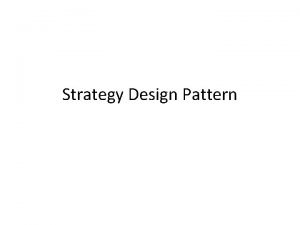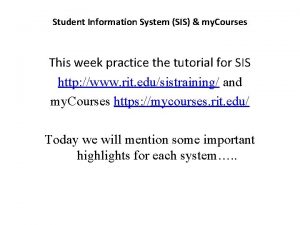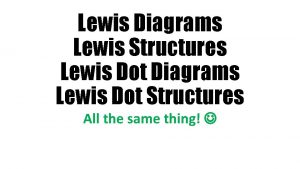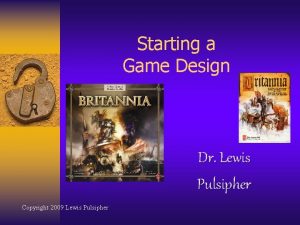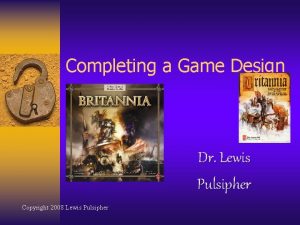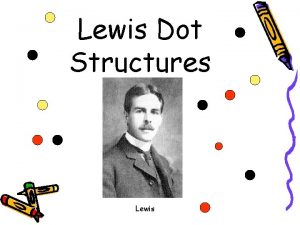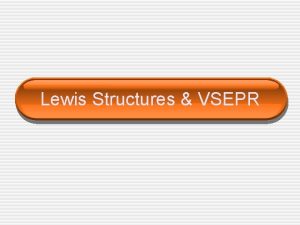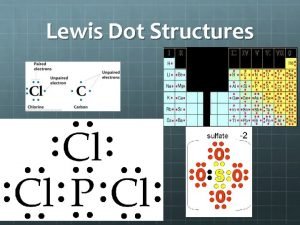Strategic Wargame Design Dr Lewis Pulsipher Courses Pulsipher

















- Slides: 17

(Strategic) Wargame Design Dr. Lewis Pulsipher Courses. Pulsipher. Games. Com

Strategy versus Tactics • It’s a matter of scale • Time Scales: – Tactical: a scale of seconds/minutes, hours, or days at most – Strategic: a scale of days, weeks, even months or years • Distance Scales: – Tactical: yards up to a few miles – Strategic: dozens to hundreds of miles, sometimes even more • Unit Scales: – Tactical: individuals or small units (ships, squads, platoons, even battalions and regiments) – Strategic: divisions, corps, armies, fleets

Battle, War, and Conquest • Joe Angiolillo’s taxonomy of war related games: – Games about war – Wargames – Simulations • Games about war – – – no connection with reality symmetric no variation in terrain and units no representation of actual or even fictional events no attempt to tell a story • Games such as Conflict, Risk and Chess fall into this category.

• Wargames – asymmetric – variation in terrain and units – real or fictional event is depicted – there is an explicit story involved (remember "story" is part of his. STORY) • Simulations – wargames taken to an extreme – term papers with board and pieces and no concern for play balance – more or less forces particular outcomes in order to match history

My categorization: War games • The heart is economy • Ultimate objective is to improve your economic capacity and destroy the enemy's • For two players, occasionally for more than two • Cover years or even centuries • Territory usually equates to additional forces, following the age-old principle that land equals wealth • More likely to use areas (like a normal map) • Generally large-scale and strategic

Battle games • No economy, instead an Order of Appearance/Battle • Ultimate objective is to destroy opposing units because they cannot get more than scheduled • Intermediate objective (e. g. territorial, or even “capture the king”) as a victory avoids much of the tedium of destroying units • Almost always for two players • Usually cover a few days to a year or so • Territory is only useful for the terrain and geopolitical implications • Usually maneuver-focused, and often use a hex or square grid • Generally smaller scale and tactical/grand tactical – but History of the World is also a battle game!

Conquest Games • Can be either war or battle game, usually war • Are usually in Joe’s “Games about war” category • Very few "realistic" or real world restrictions on what you can do--"freedom to do whatever you want" • Attacker can always get the upper hand (odds favor those who attack-attack), so it’s not strategically wise to play defensively • Usually symmetrical • Typically large scale • Combat typically very simple • Particularly attractive type of game related to war for those who aren’t hobby gamers

Models • War and battle games are models. They try to reflect some reality • Models MUST simplify – reality is too complex • Where is the line between model and simulation? – Simulations are models – Simulations may try to model causes rather than just effects – Simulations value the model more than the game • Games that aren’t models are abstractions – Even if there’s the atmosphere of a story attached

Economies • Accumulation economy – You can build units regardless of how many you already have – That is, existing units cost you nothing – no maintenance – Risk, Axis & Allies • Maintenance economy – You must pay for existing units before building more – Prevents accumulation of very large armies – Diplomacy’s extreme supply center economy (you can build any unit as long as you can maintain it)

Pseudo-economy • In games that depict a single battle there is rarely an economy, but there can be order-ofbattle based objectives that introduce something like an economy • For example, a side may get a few reinforcing units if they can take a particular road junction • This pseudo-economy can occur in games that have a regular economy, as well. • Chess promotion, checkers “kinging”

Advantages of Designing Strategic Games • No one telling your “nuts and bolts” are bad because you disagree with them about penetration power! • You don’t have to worry about exact numbers • On the other hand it’s even harder to model for cause rather than effect • But modeling for effect is just as educational, at this scale

Purposes of Wargames • • Training Learn history Teach history Geography etc. [Greg’s “where’s the German city” answer] • And entertainment

The big Dichotomy • Game players want control – They want to feel they succeed or fail on their own merits • Real war is a “mess” – “For want of a nail. . . ” • The two are not compatible! • Conquest games are all about control – no “realistic” mess required • Simulations MUST reflect at least a portion of the “mess” • But not all of it (or as much as games can do), because it would be frustrating to game players

Commander’s Problems Both strategic and tactical • Command Control – failure of leaders (to do what they're told) – failure of communication (doesn't get thru) – failure of understanding (when it does get thru) • Uncertainty – of enemy intentions – of the real strength of units of both sides – of the number of enemy units

• Fog of War (can't see beyond your own LOS, smoke) – Where is the enemy – (Sometimes) where are your own units – Common in video games, where it's the natural way things work • Morale and failure of morale – Fear of Death – Fear of Failure (pressure) – Tends to dominate many miniatures rulesets

Some ways to represent these problems • • • Block games “Activations” Upside down units Chit draws Team play (miniatures) – Especially with written orders • Computer intervention • BUT DON’T OVERDO this representation, or the game becomes the “mess”

Tabletop wargames are nothing like reality • And in any case it will never really feel like the real thing • Those who emphasize “you are there” are fooling themselves. Then again, they wouldn’t want to really be there… • Video games can come closer to the visceral feeling, but often are more abstraction than model
 Andrew pulsipher
Andrew pulsipher Opr wargame
Opr wargame Assassin's mace wargame
Assassin's mace wargame Unsw art and design short courses
Unsw art and design short courses Strategic fit vs strategic intent
Strategic fit vs strategic intent Strategic complements and substitutes
Strategic complements and substitutes Strategic management and strategic competitiveness
Strategic management and strategic competitiveness Strategic analysis and choice in strategic management
Strategic analysis and choice in strategic management Strategy pattern uml diagram
Strategy pattern uml diagram What shapes internal structure
What shapes internal structure Wipo academy courses
Wipo academy courses Legal labelling courses
Legal labelling courses Ung oconee majors
Ung oconee majors Biology major stony brook
Biology major stony brook Phys courses ucsd
Phys courses ucsd Sis mycourses
Sis mycourses Simad university courses
Simad university courses Queens college in thanjavur
Queens college in thanjavur








